
When teachers are working with Depth and Complexity, one of the challenges they face is how to adapt already-existing content to the framework. It can seem harder to take what you have and infuse it with high-level thinking than to just start from scratch.
In addition to the articles on this site and the book I wrote with Ian Byrd about Depth and Complexity, I like to work with real lessons from real teachers.
I’m going to walk you through my process of doing this, and I’m going to give you the finished product as a free download you can use!
As you read, you’ll notice that I use emoji to represent the thinking prompts of Depth and Complexity. You may be used to the common icons, and that’s fine, too.
Poetry Annotation Original Assignment
I was the keynote speaker at the Ohio Association of Gifted Children Teacher Academy conference, and I was doing a session on Depth and Complexity Case Studies where I showed how to turn a regular assignment into a Depth and Complexity assignment like magic.
I asked teachers to submit lesson plans for me to adapt, and I received one. Yep, one.
There’s a great lesson here, because I was able to spend all of my time on this particular lesson, so this teacher’s lesson got the full spa treatment!
The teacher, Michael Whitmore at Ravenna High School in Ravenna, Ohio, is himself a poet and loves teaching poetry. He’s even published a book of poetry called Plum Picking.
This assignment was one he uses frequently – it’s one of those terrific assignments that can be used over and over with different works of poetry. I love those, don’t you?
This is what it looked like when he shared it with me:
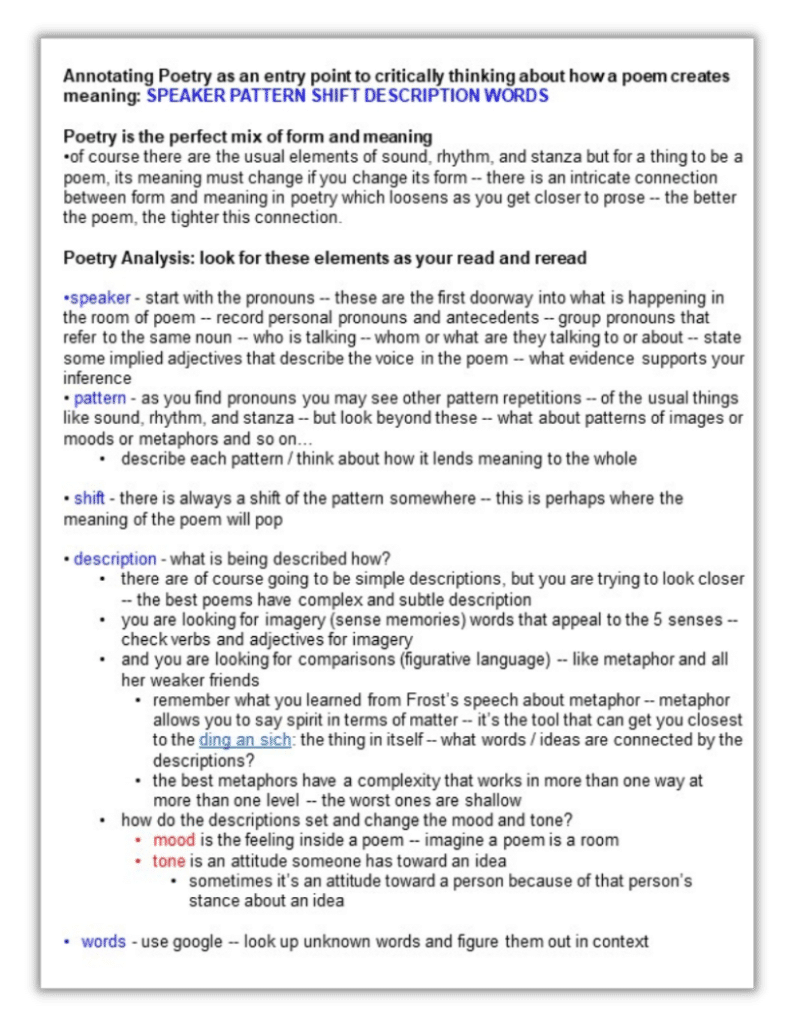
It also included this diagram showing the interconnectedness of poetic elements and relationships:
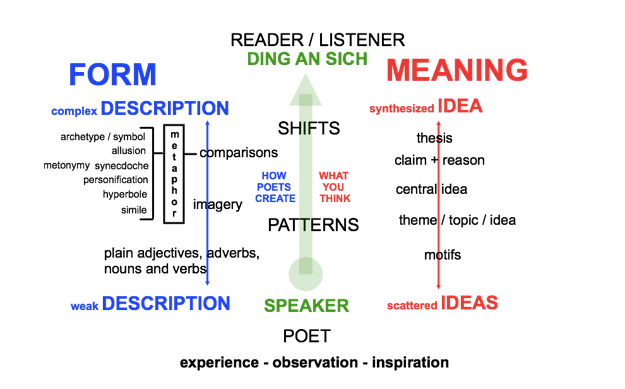
Step 1: Review Original Activity and Note Thoughts
When I look at an activity or lesson with an eye to infusing it with Depth and Complexity, these are the things I do first🚦:
- Scan it if you know it well, and read more closely if it’s the first time you’re seeing it.
- Think about how what you’re seeing makes you think of elements of Depth and Complexity. [I keep my Depth and Complexity Quick Guide handy while I do this.] Note the thinking promts or content imperatives that the lesson brings to your mind.
- Take some notes as you go along. These don’t need to be complicated. Just jot down what thoughts occur to you as look it over.
This is the method I use, which I why I have the 🚦 emoji I use for Rules here. Methods are Rules.
Reviewing a poetry annotation activity
I thought it might help you to see how I did this step-by-step, so I’m going to show you the original text with my thoughts typed up. The orange boxes are my thinking.
1. Think
When I first look at the lesson or activity, I put on my Depth and Complexity thinking hat. This process doesn’t take a lot of time to do, but it does require deep thinking. If I want my students to think deeply, I, too, must think deeply.
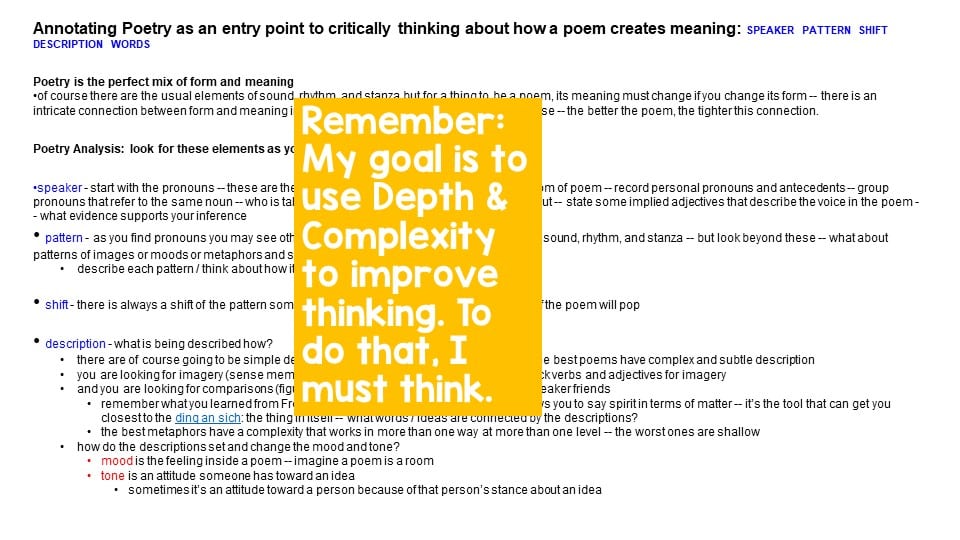
2. Organize and think about how it looks
Using Depth and Complexity not only helps me organize the information – it helps make it less overwhelming to students and adds an element of pleasing aesthetics.
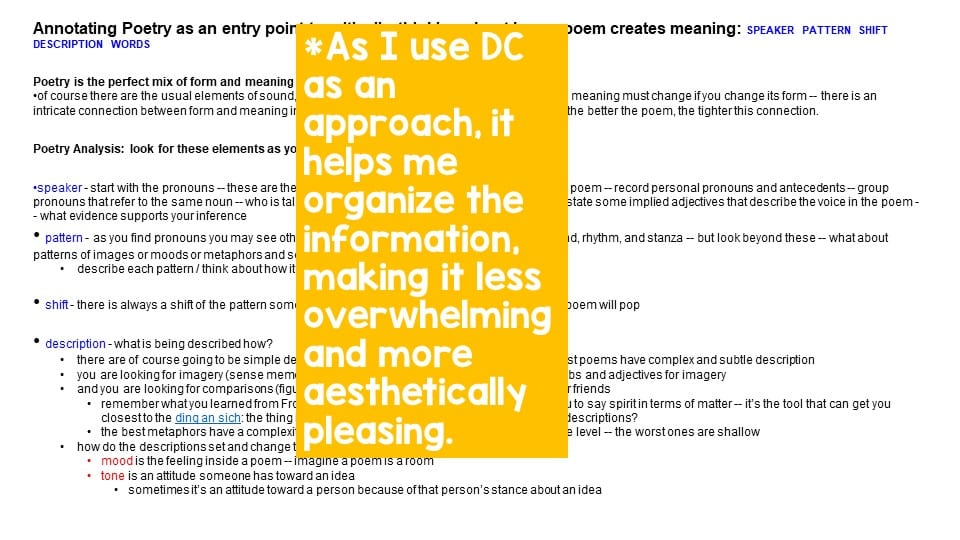
Students like things to look good, too. It’s a sign someone cared about the content.
3. What are the tools I have available to me?
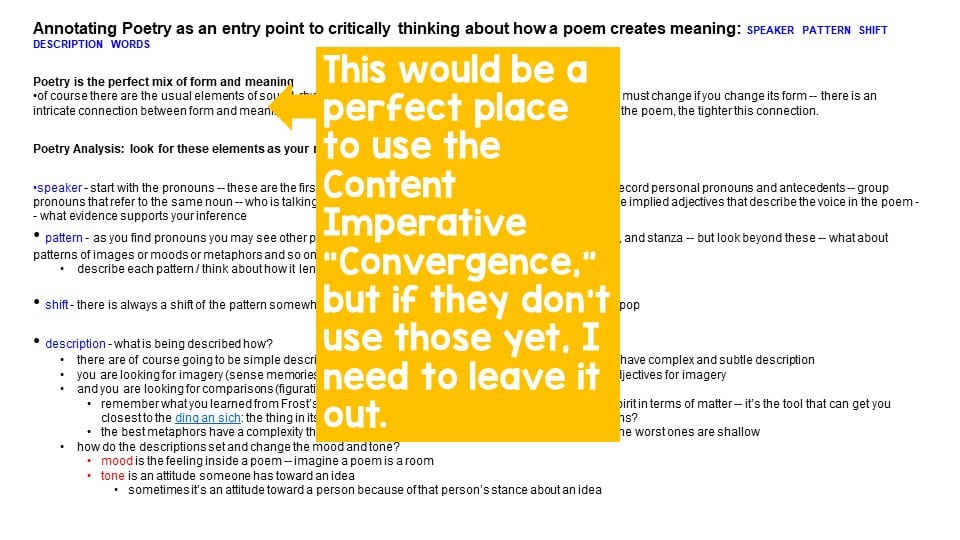
I have to consider what Depth and Complexity tools the students already have. I don’t like to combine new content with new prompts of Depth and Complexity. Here’s the rule of thumb:
- New thinking prompt combines with already-learned content
- New content combines with already-learned Depth and Complexity thinking prompt
In this case, it’s a Content Imperative that occurs to me, but the rule is the same: I’m not going to give them a new aspect of Depth and Complexity with new content. There is too much chance for confusion that I won’t be able to figure out. Are they confused by the content or the Depth and Complexity element?
Here, I decide to leave out the Content Imperative of Convergence because they don’t know it [yet].
4. Look for the 🌳Big Idea
It’s critical that I find the 🌳 Big Idea of the activity or lesson. Without that, I won’t know what the activity is leading students towards. I will do three things with it in the revised activity:
- Identify it (Make sure they know it’s the Big Idea.)
- Isolate it (Make sure it’s on its own and not blended in with a bunch of other ideas.)
- Emphasize it (Use design to draw attention to it.)
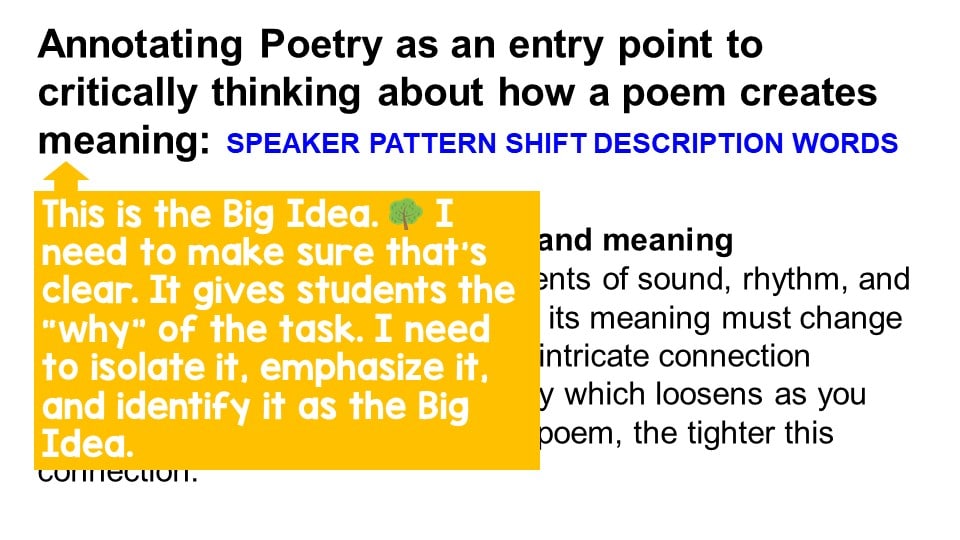
Below, you can see that as I read on, I saw 🍃 Details listed after the 🌳Big Idea. I need to pull those away from the Big Idea. The Big Idea is like the cheese: The cheese stands alone.
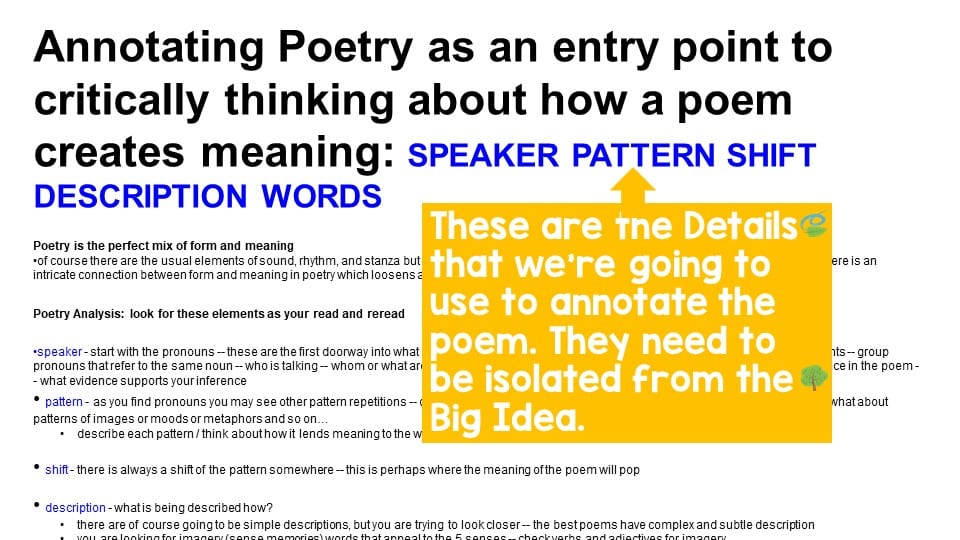
5. Avoid feeling pressured too early to make a decision
As you see here, I wasn’t sure whether this was a second 🌳Big Idea I was seeing, or if it were a continuation of the first 🌳Big Idea I identified above. I don’t worry about it; I just make a quick note and move on.
Because I was doing this for other people, I wrote it out, but on my own notes, it just had this notation: “2nd 🌳?”

6. Is there a method?
If there’s some kind of method or steps students are supposed to follow, I definitely want to identify that. Remember: Methods are 🚦Rules. It doesn’t matter if it’s the Scientific Method or following a recipe where you cream the butter and sugar first. Methods are 🚦Rules.
I want to make sure that I point that out to students. By seeing it as a 🚦 Rule, they know right away that it’s not optional, that something unsavory will happen if they don’t do it the correct way, and that the crux of their activity will be found here.
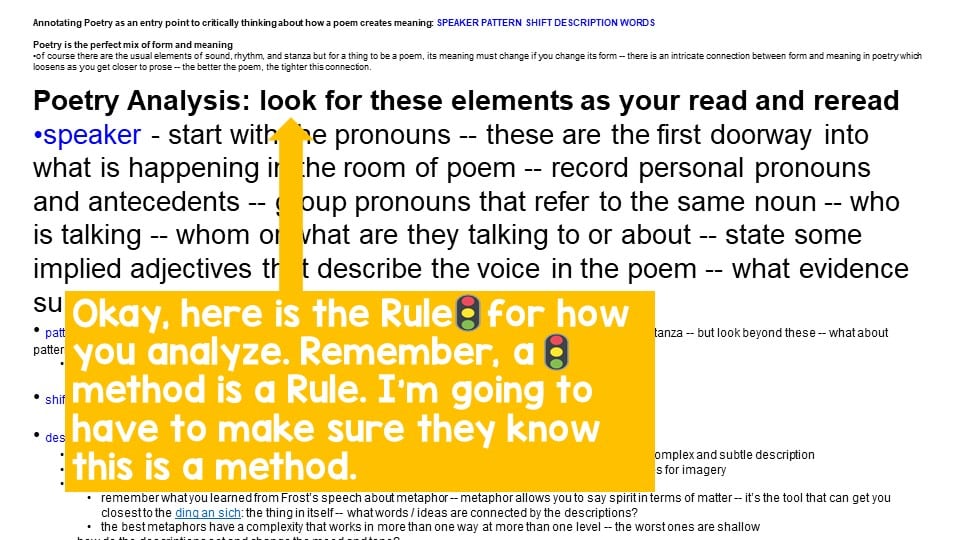
7. Are some parts of the lesson more than one element of Depth and Complexity?
It’s very possible that a single item can be looked at through more than one lens of Depth and Complexity. Here, you see that I was seeing both 🍃Details and 👄Language of the Discipline.
When I see this, I have two choices:
- Use both elements
- Pick the one I want to emphasize
There’s no right or wrong, but I may need to mention, “Oh, hey, this is also blah, blah, blah.”
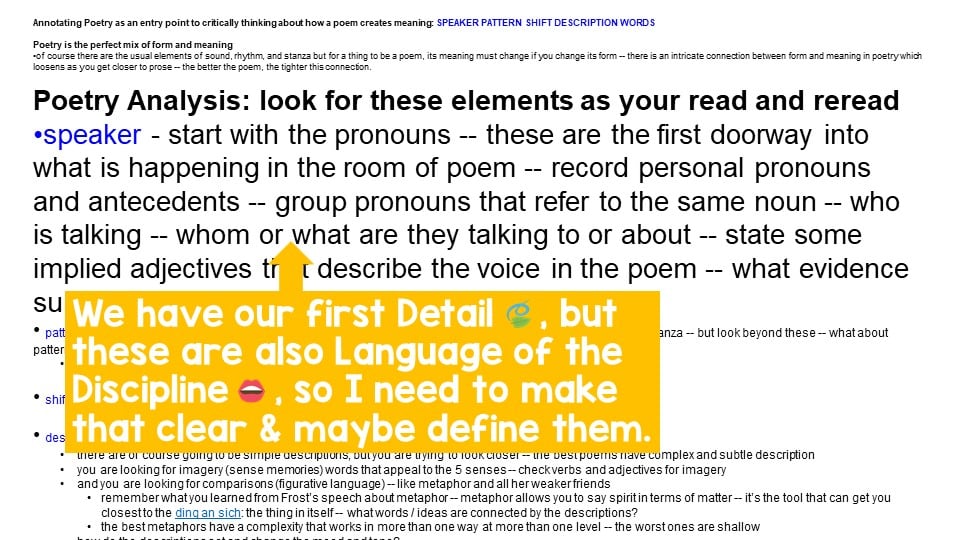
This may come up several times through the course of a lesson. Here, you can see that I had the same thing occur to me later in my scan. I decided to use formatting changes to make it clear that there’s a method here.
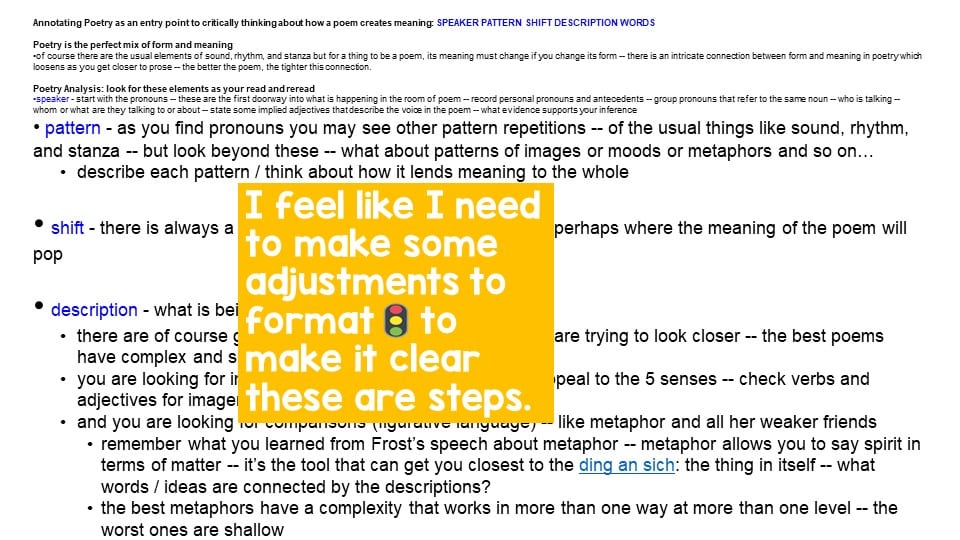
8. Look for possible confusion
Part of my job as a teacher is to make sure to balance desirable difficulty with frustration. I also want to make sure that students know what every part of the assignment is asking them to do/think.
Here, I’m a little concerned that the task and the direct instruction are muddled, and I’m noting that I want to tease those apart.
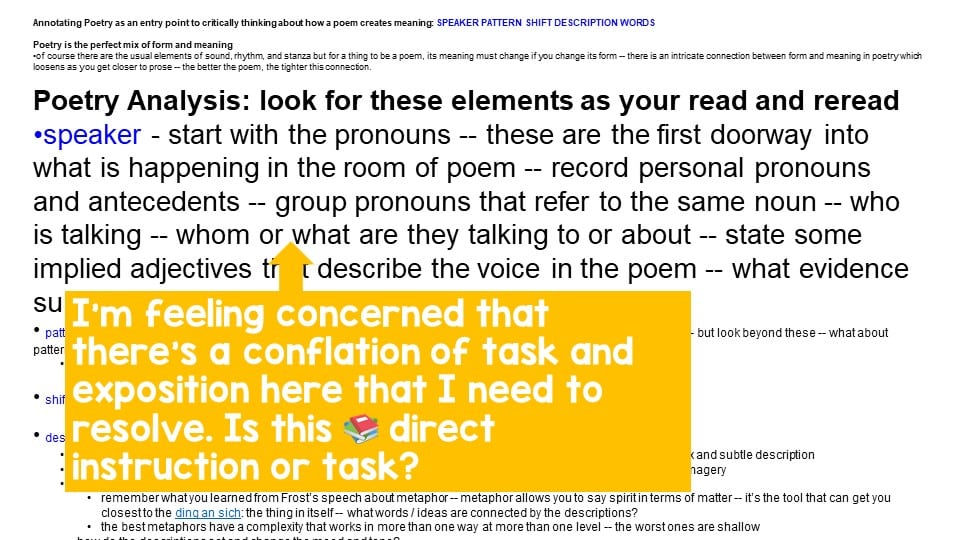
I don’t have to decide what to do with it right then on first scan. I just make a note of it and let my brain think about it in the background as I move on.
In this case, I’m sharing a spoiler: I decided to strongly separate the task from the direct instruction.
Second spoiler: I nearly always do this. I find it to be a best practice.
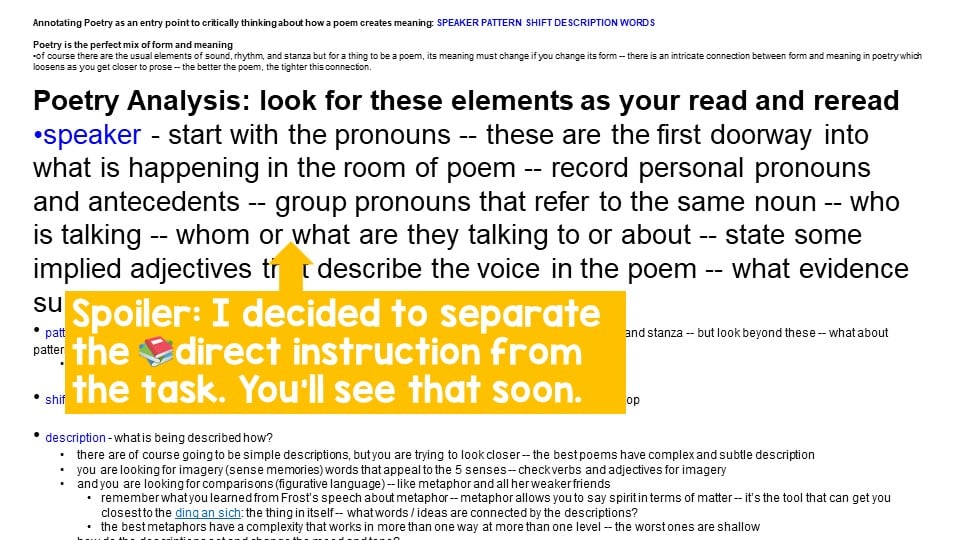
9. Repeat as necessary
As I read through, I keep repeating these steps as they come up. Here, I’ve found more 🍃 Details supporting a 🌳Big Idea, and these 🍃Details are all 👄Language of the Discipline.
It’s important to note this repetition in a task or lesson because 🌀Patterns begin to emerge that you can use to organize your lesson.

10. Look for possibilities for general improvement
It’s not just about Depth and Complexity. As I go through a lesson, I’m scanning for ways I can add to the lesson, deepen the experience for students, support struggling students, or make other adjustments that strengthen the learning opportunity.
Here, you can see that the original lesson mentioned a speech the students had read/studied. I can link to that speech in case students forgot/want to revisit. Hey, a teacher can dream, right?
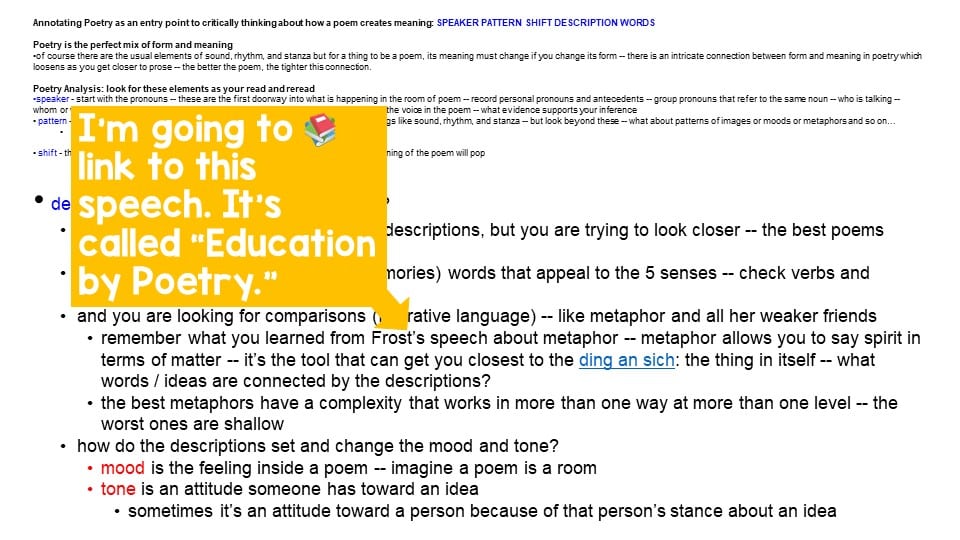
11. Pay attention to visual elements
Visual elements require a three-part evaluation.
- How can Depth and Complexity improve the visual?
- What role does the visual play in the overall lesson?
- Are the visuals aethetically appropriate?
Below, you can see that I’m considering where this visual best fits.

I also have some concerns about the aesthetics. It feels a little busy, with a little too much visual noise. As I look it over carefully, I realize that nothing can be left out and have it retain its meaning. I also realize it cannot be separated into two separate diagrams, either.
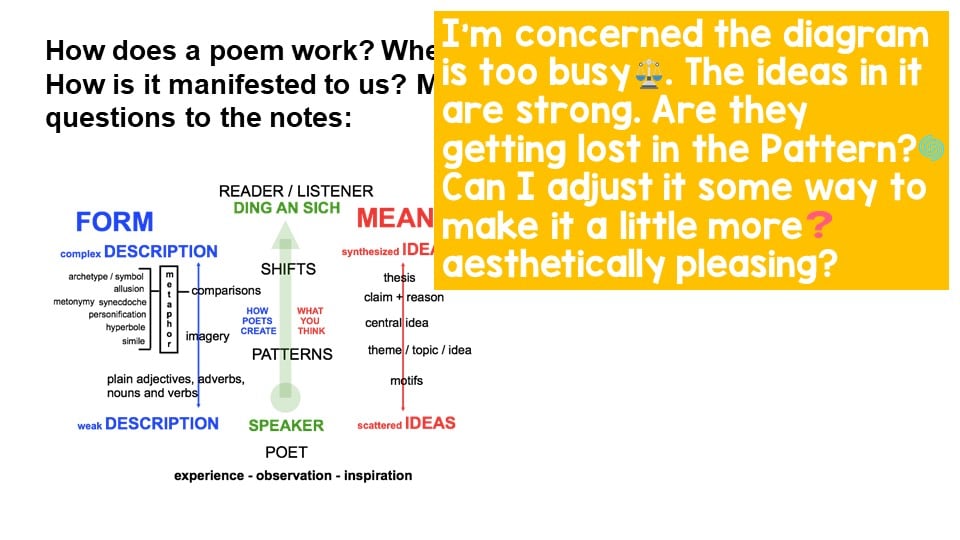
I decide to go on a site called Fiverr that lets me hire a graphic designer to redo the image for me. It cost me $10, which was money very well spent.
Remember, this is a multi-use activity. I’ll be using it for years, multiple times per year.
Redoing the design myself would have taken me a couple of hours, so $10 for two hours is a smidge above a teacher’s normal pay (!), so it’s worth it.
[You can use my affiliate link to Fiverr to get 10% your first order, if you want to try it out. I have them do everything from whiteboard videos to stuff like this!]
This is what the designer came up with.
- Notice the emoji representhing the thinking prompts of Multiple Perspectives, Big Idea, Pattern, and Language of the Discipline?
- Notice how the colors draw your eye and balance the design?
- Notice how the white space makes it a little easier to follow?
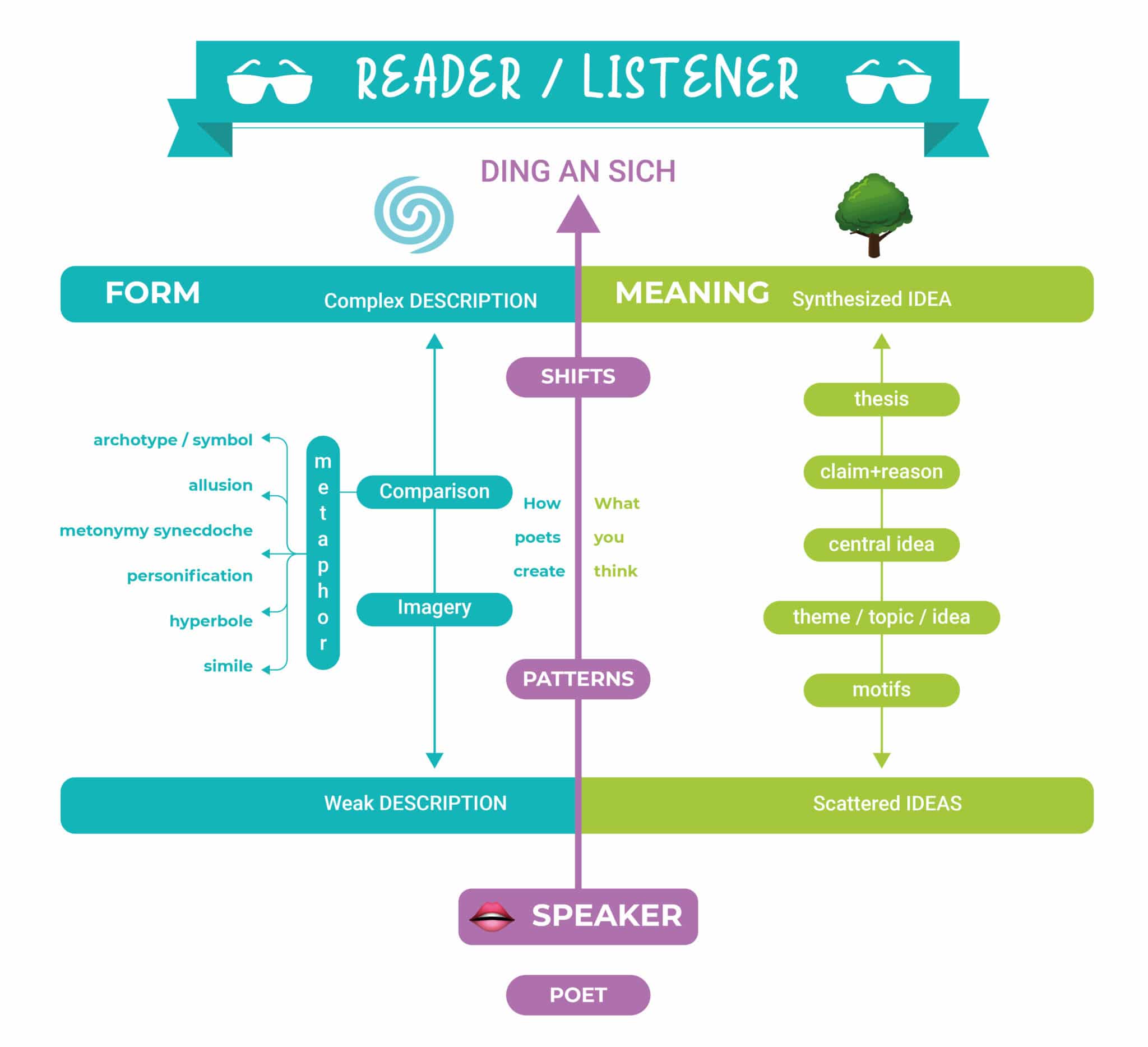
Recap of Step 1:
This process only seems long because I split into all of its steps and wrote it out for you. The actual process took me only 15 minutes to do, and it would have been shorter if I hadn’t put in the order to Fiverr for the graphic design work.
As you get used to doing this process, I promise that it will become second nature and very, very quick.
Once you’ve reviewed the original assignment and noted your thoughts, you’re ready to revise the assignment.
Step 2: Revise the Assignment
The real fun begins now. I get so excited at this part because I know I’m going to be take something good and make it even better! I love that!
When I was done, it looked like this:
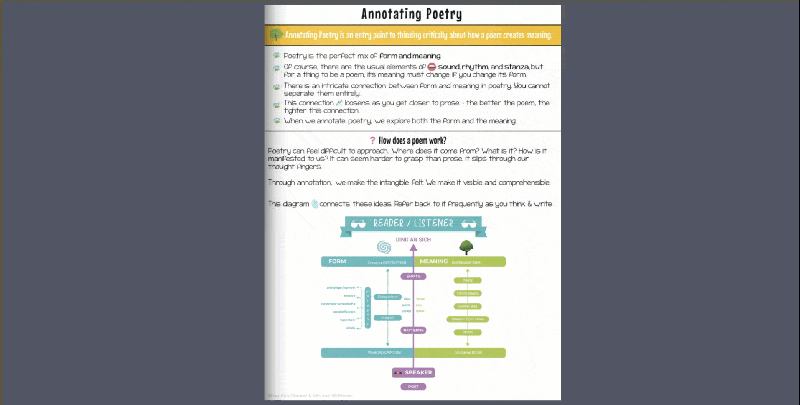
Quite a change!
The core ideas are there (credit to Michael Whitmore!), and I’ve added in tons of instruction, application activities, and a rubric. Because we need a rubric. Always.
If you already know you want the finished activity (it’s free!), just click the button.
First, I pulled out the 🌳Big Idea.
I wanted that 🌳 Big Idea to shine. This won’t surprise you because I talked about why that’s so important above. I used color and design to make it clear: THIS IS THE 🌳BIG IDEA OF WHAT WE’RE DOING HERE!
Below that, I put shared the 🍃 Details that supported that 🌳 Big Idea.
I put the revised diagram here, and you’re going to see it later, too.
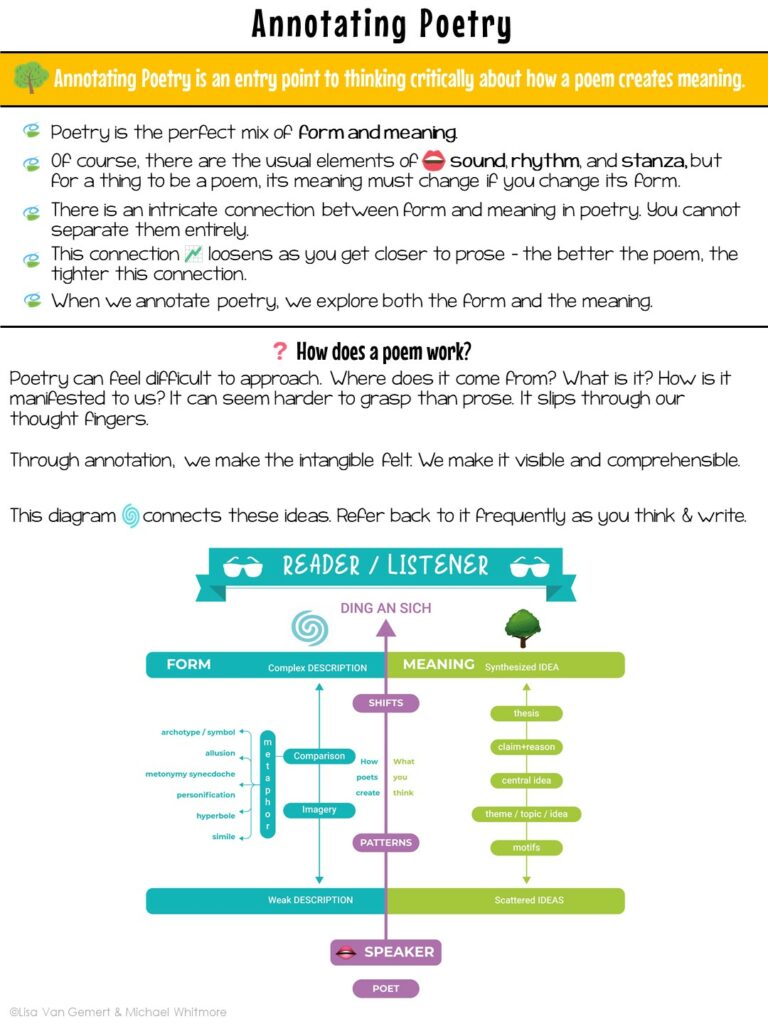
Next, I separated the task from the direct instruction
As you saw above, I felt strongly about separating the task from the direct instruction. To do that, I used text boxes colored in grey to highlight the direct instruction.
Things to notice:
- I used check boxes to clearly show that the task had steps.
- Notice the 🚦Rules emoji right there next to the word “method”? That makes sure my students know they need to follow this or they run the risk of being lured to the dark side.
- I separated it out into four steps, divided by a dark line.
- I decided to include a practice element, so I used two poems from my favorite living poet, Billy Collins. I’ve met him in person, and it was amazing. He hugged me. No, really.
- Depth and Complexity elements are noted with the emoji and/or name of the thinking prompt.
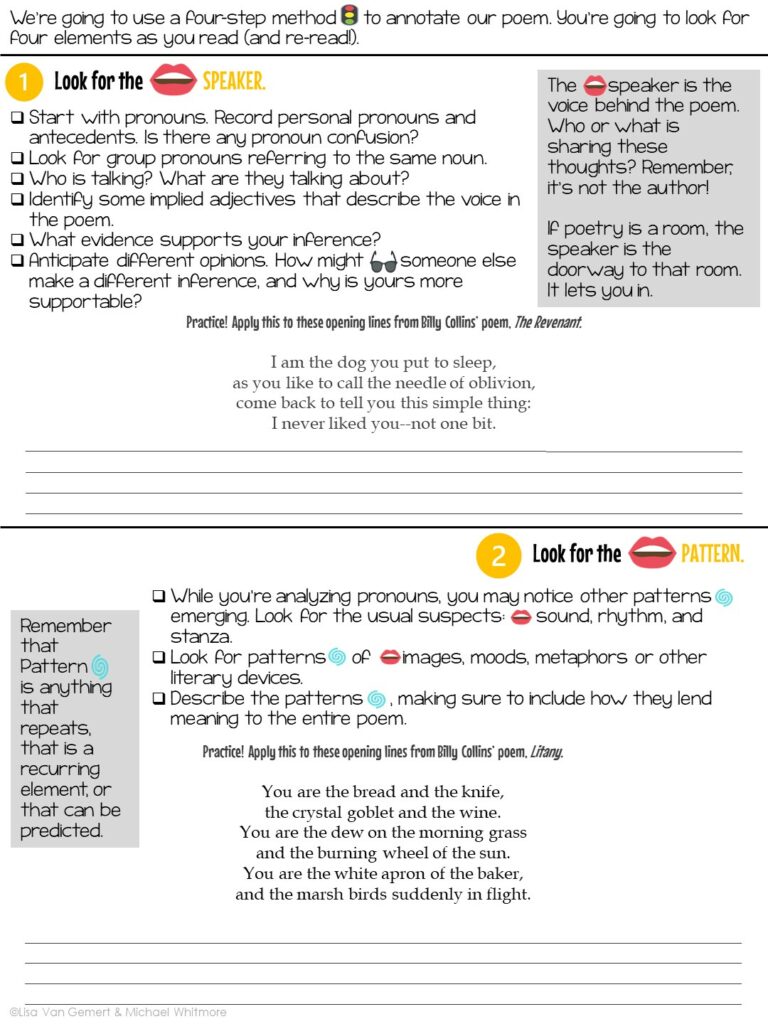
Next, come back to the diagram
After I did two pages of those four steps (half a page per step, including the application practice), I revisited the diagram again. I actually put it in the activity twice. That did two things:
- It showed students that it was important enough to be included twice
- It gave visual interest to the activity
I didn’t want them just to see the diagram there and move on. I knew that to make it useful, they had to work with it. So, I created a few Depth and Complexity questions to go with it. I pulled out my handy-dandy Depth and Complexity Question Stems book, and I came up with three questions I felt would help students focus on the diagram.
You may be wondering why, if I wrote the books, I need to reference them. Friends, it’s a lot to remember, and I get in a rut of my favorite questions and prompts. The books help me keep my practice fresh.

You can see how the diagram creates that visual interest that I find keeps students focused longer than large blocks of text.
You may notice I think it helps adults, too.

Add in the practice poems
I wanted to include the full text of the practice poems because Billy Collins. This poem is one of my favorites, ever ever ever.
To me, this is part of the Depth and Complexity practice of Disciplinarianism. We don’t just look at the part of the poem our teacher is asking us to analyze. We read poems because we’re poetry readers.
Leaving out the full text sends a weird, mixed message to students.
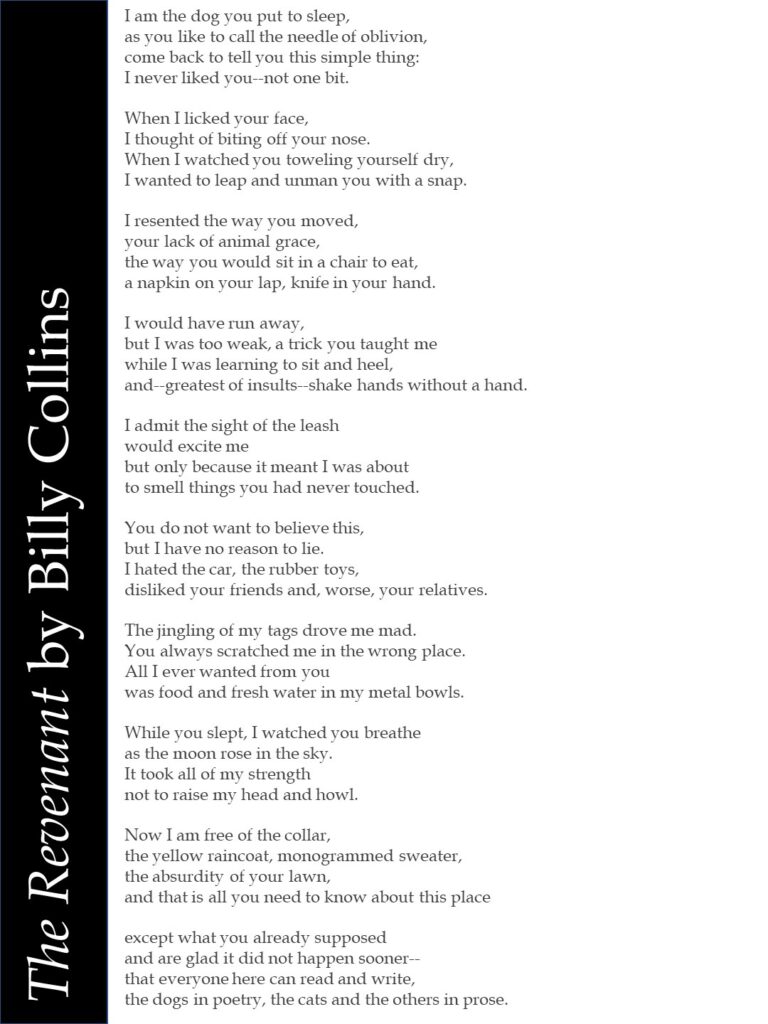
Give a little more practice
I got this far, and then I decided I really wanted them to have more practice with this in a way that would let the students know they truly understood the process.
So, I created a series of questions about one of the poems, and had them apply what they’d learned to that poem.
People who know me could read this and know I wrote it. I teach my students to write with voice, so I need to also.
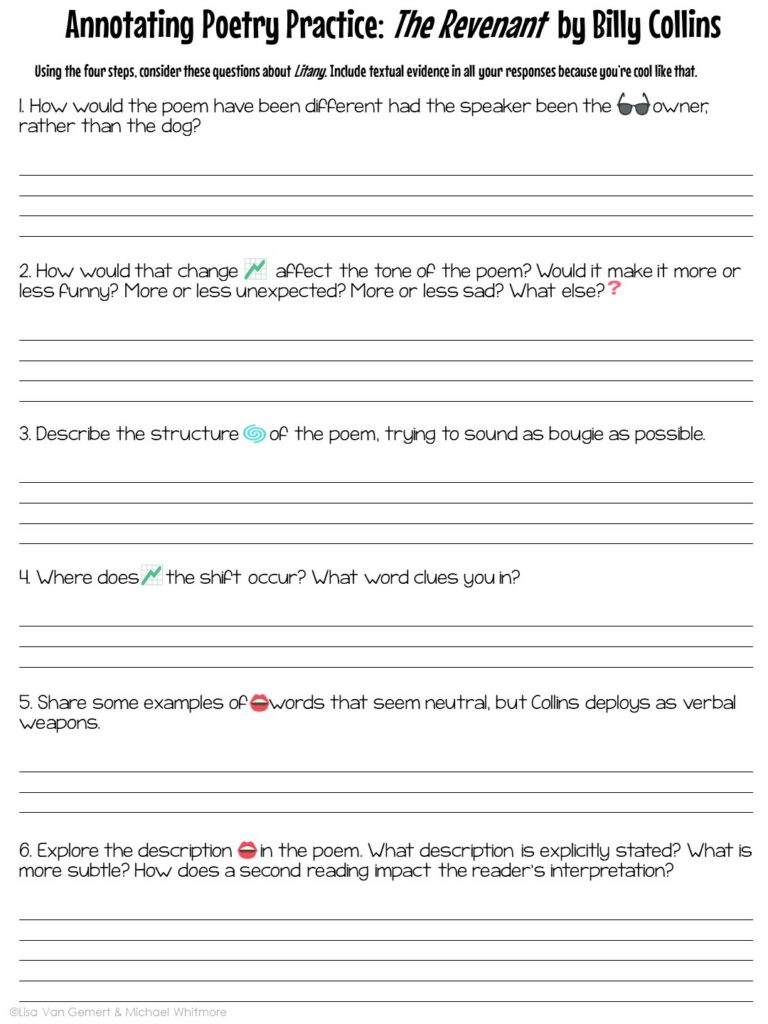
Lastly, include a rubric
Rubrics are one of those magical things that are good for both teachers and students. Students need to know the expectations, and teachers need to evaluate quickly, fairly, and with reasonable precision. Ta-da! A rubric!
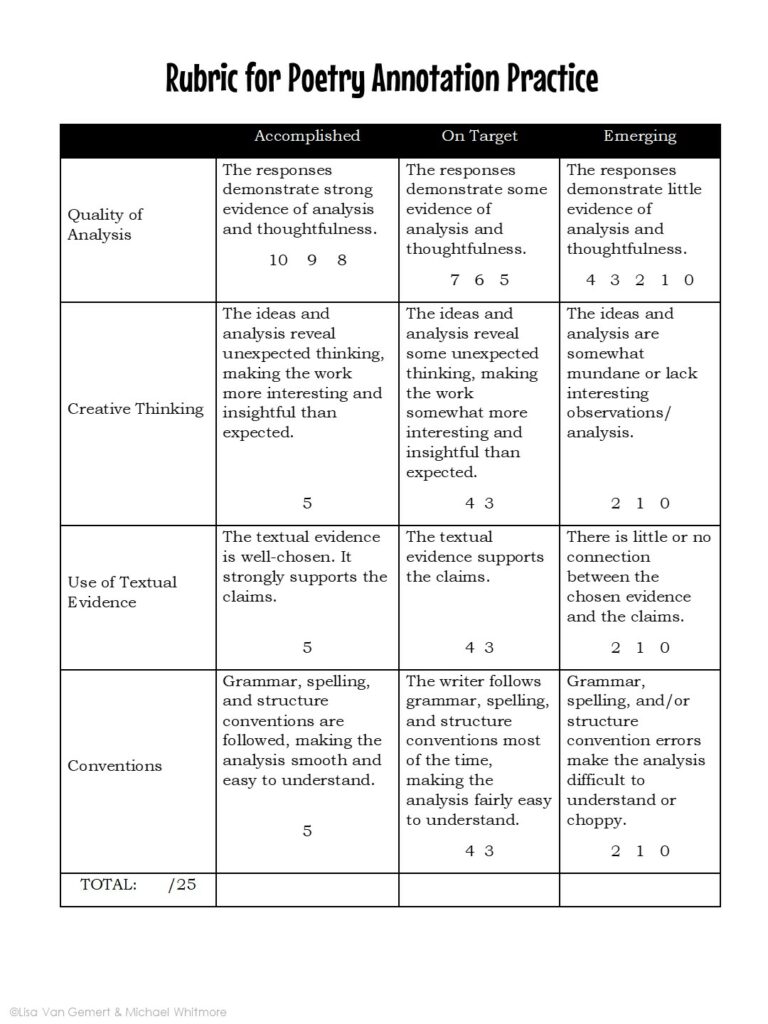
The only time saver that comes close to that of a rubric is calculus.
If an assignment doesn’t have a rubric, that will be a must-change for me, always.
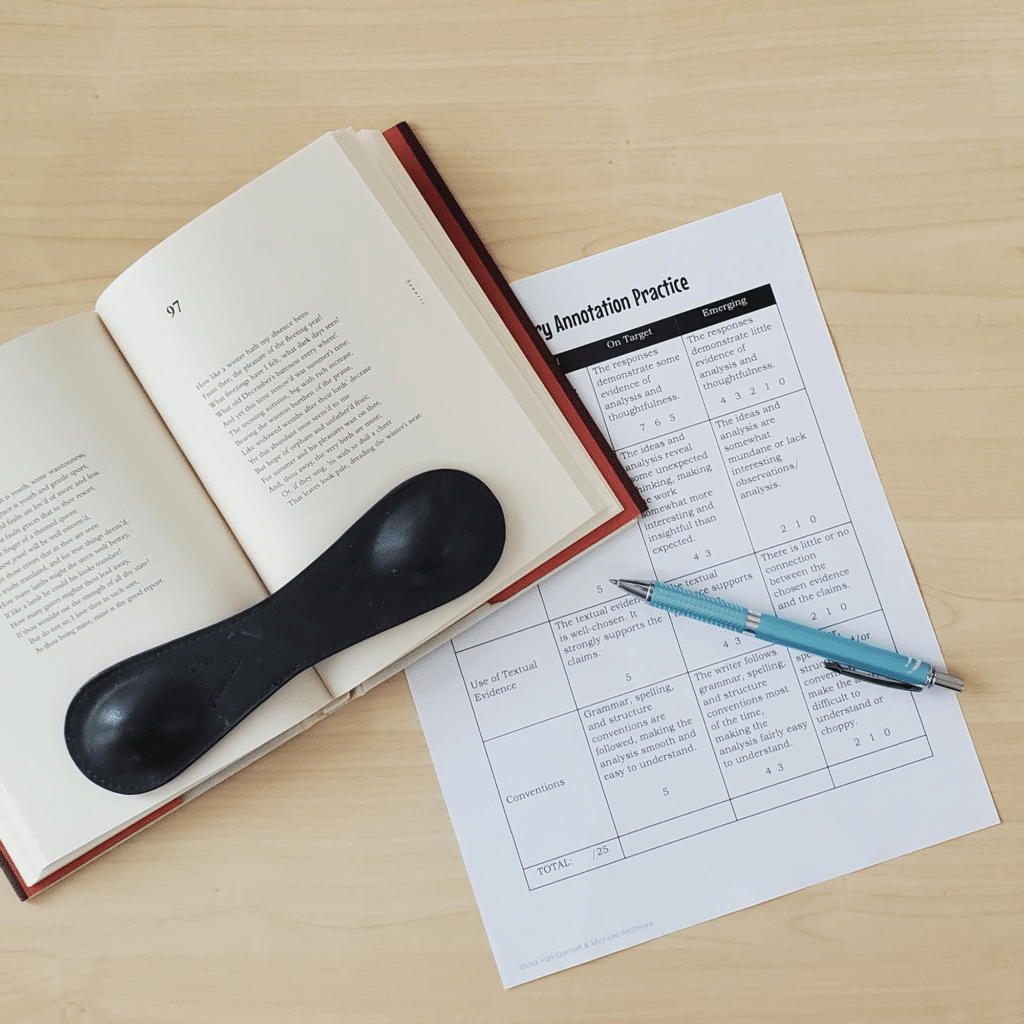
Wrapping Up
I hope it’s been helpful for you to see this process as I took something that was not using Depth and Complexity and converted it to a Depth and Complexity activity.
Yes, you could make the argument that I changed the activity significantly, not just added Depth and Complexity.
That’s true, yet it’s because of Depth and Complexity that I thought to do that.
It’s because I have learned to deepen thinking through the use of the Depth and Complexity framework that these things occurred to me.
Depth and Complexity is about far, far more than throwing a bunch of icons on a page and calling it good.
It’s about recognizing that we can take good things and make them more powerful than they have ever been by deepening the entire learning experience.
I’d like to thank Michael Whitmore for allowing me to take his terrific activity and give it a Depth and Complexity glow-up. I appreciate his generosity in allowing me to share it for free with teachers just like you.
You May Also Like
I write a lot about Depth and Complexity, so if you’re interested in learning more, you may enjoy these articles:
- This is the big home article I’ve written on Depth and Complexity
- Are You Making this Depth and Complexity Mistake?
**If you want to become a Depth and Complexity master, you can take the Depth and Complexity Course. Learn more here.


